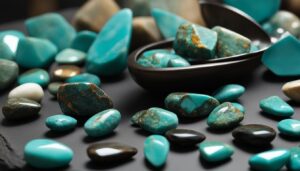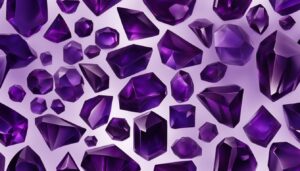The Fascinating Formation of Moonstone: A Journey through Geology
When it comes to the world of gemstones, the moonstone holds a special place. Known for its ethereal glow and unique sheen, moonstone has captivated people for centuries. But beyond its beauty, moonstone also has a fascinating geological story to tell. In this article, we will explore the journey of moonstone from its formation deep within the Earth to its discovery and use in jewelry and other decorative items.
The Geological Origins of Moonstone
Moonstone is a type of feldspar, a group of minerals that are among the most abundant on Earth. The specific type of feldspar that forms moonstone is known as orthoclase. What sets moonstone apart from other feldspar varieties is its unique adularescence, which is the phenomenon where light appears to billow across the surface of the stone, creating a striking play of color and sheen.
The adularescence of moonstone is caused by the intergrowth of two different types of feldspar within the crystal structure. As light strikes these intergrown layers, it is scattered in a way that creates the characteristic sheen and iridescence that moonstone is known for.
The formation of moonstone begins deep within the Earth’s crust, where molten rock, known as magma, slowly cools and crystallizes. As the magma cools, minerals such as orthoclase feldspar begin to form. In some cases, the cooling process is slow enough to allow the formation of the intergrown layers that give moonstone its unique optical properties.
Discovery and Early Use
The exact origins of moonstone’s discovery and early use are shrouded in the mists of time. However, it is known that moonstone has been valued for its beauty for thousands of years. Ancient civilizations such as the Romans and Greeks used moonstone in jewelry and decorative items, often attributing magical and mystical properties to the stone.
In India, moonstone has been revered for centuries as a sacred gem, believed to be imbued with the power of the moon. In Hindu mythology, it is said that moonstone was formed from the rays of the moon, giving it a special connection to the celestial body from which it takes its name.
Today, moonstone is still mined in several locations around the world, including India, Sri Lanka, Burma, and the United States. Sri Lanka, in particular, is known for producing some of the finest quality moonstone, with its characteristic blue sheen and high transparency.
The Mining and Processing of Moonstone
When it comes to mining moonstone, the process can be quite labor-intensive. In many cases, moonstone is found in alluvial deposits, where it has been eroded from its original source and washed downstream by rivers and streams. Miners often have to sift through large amounts of sediment to find pieces of moonstone, which can then be cut and polished to reveal their natural beauty.
Once the rough moonstone is extracted from the earth, it undergoes a process of cutting and polishing to enhance its natural iridescence and color. Moonstone is often cut into cabochons, which are polished, domed stones that showcase the stone’s unique play of light and color. In some cases, moonstone may also be faceted to create a more reflective and sparkling appearance.
Modern Uses of Moonstone
Today, moonstone continues to be prized for its otherworldly beauty and unique optical properties. It is used in a wide range of jewelry, including rings, pendants, bracelets, and earrings. The stone’s iridescence and soft, dreamy glow make it a popular choice for bohemian and vintage-inspired designs, as well as modern and minimalist pieces.
Beyond jewelry, moonstone is also used in decorative items such as carvings, beads, and objets d’art. Its mystical associations and timeless allure make it a popular choice for those seeking to add a touch of magic and mystery to their surroundings.
In addition to its aesthetic uses, moonstone is also believed by some to possess metaphysical properties. It is said to promote inner growth and strength, balance emotions, and enhance intuition. Many people wear moonstone as a talisman or amulet, believing that it can bring good fortune and protection.
Conclusion
There is no denying the enduring appeal of moonstone, from its geological origins to its use in modern jewelry and decorative arts. Its ethereal beauty and mystical associations continue to captivate people around the world, making it a gemstone that is truly timeless.
The Role of Feldspar
One of the key components in the formation of moonstone is the presence of feldspar, a type of mineral commonly found in the Earth’s crust. Moonstone is a variety of the feldspar mineral called orthoclase, which occurs in a range of colors, including white, gray, green, pink, and peach. What makes moonstone unique is its adularescence, a phenomenon in which light is scattered and reflected off the internal structure of the stone, giving it a luminous glow reminiscent of moonlight. This effect is caused by the presence of thin, alternating layers of orthoclase and albite, another type of feldspar, within the stone.
Formation in Pegmatite Veins
Moonstone is often found in pegmatite veins, which are a type of igneous rock formation that occurs when magma-rich in water and other volatiles cools and solidifies. The slow cooling process allows for the formation of large crystals, including those of feldspar, which are essential for the creation of moonstone. As the magma slowly cools and crystallizes, it creates veins of pegmatite that can contain pockets of moonstone and other minerals. The unique conditions within these pegmatite veins, including the presence of water and specific chemical compositions, are crucial for the formation of moonstone.
The Influence of Astronomy
The name “moonstone” is thought to be derived from the stone’s ethereal glow, which resembles the moon’s soft, silvery light. However, the influence of astronomy on moonstone goes beyond its name. In ancient cultures, moonstone was believed to be connected to the moon and its phases, and it was often associated with feminine energy and intuition. The Romans, for example, believed that moonstone was made from solidified moonbeams, while in India, it was considered a sacred stone that brought good fortune. This association with the moon and its mystical properties has contributed to the allure and fascination surrounding moonstone throughout history.
The Geological Significance
Beyond its cultural and aesthetic importance, the formation of moonstone holds significant geological value. Studying the conditions under which moonstone forms can provide valuable insights into the processes that occur within the Earth’s crust, including the crystallization of minerals from magma, the role of water in mineral formation, and the formation of pegmatite veins. By understanding the geological factors that contribute to the creation of moonstone, geologists can gain a deeper understanding of the Earth’s history and the forces that shape its surface. Additionally, the properties of moonstone, including its adularescence and lustrous appearance, make it a fascinating subject for researchers studying the optical and physical properties of minerals. By delving into the formation of moonstone, scientists can uncover new knowledge about the behavior of light within crystalline structures and how it contributes to the unique optical effects seen in moonstone and other gemstones.
The Unique Properties of Moonstone
Moonstone is a truly unique gemstone, prized for its iridescent sheen and ethereal glow. This optical effect, known as adularescence, is caused by light scattering off microscopic layers of albite within the stone. This gives moonstone its characteristic shimmering appearance, which is reminiscent of the moonlight that inspired its name.
In addition to its optical properties, moonstone also has distinct physical characteristics. It typically has a milky white or transparent appearance, with a hardness ranging from 6 to 6.5 on the Mohs scale. Moonstone is a member of the feldspar group of minerals, which also includes gems such as labradorite and sunstone. It forms as a result of the intergrowth of two different types of feldspar, known as orthoclase and albite, which give moonstone its unique appearance and properties.
The Geological Formation of Moonstone
Moonstone is primarily found in igneous and metamorphic rocks, where it forms as a result of the intergrowth of orthoclase and albite feldspar minerals. This can occur through a variety of geological processes, including magmatic, metamorphic, and hydrothermal activity. For example, moonstone can form in pegmatite deposits, which are coarsely crystalline igneous rocks that often contain a variety of gemstones and minerals.
In some cases, moonstone can also be formed through metamorphism, which involves the transformation of existing rocks under high pressure and temperature conditions. This can lead to the recrystallization of feldspar minerals, resulting in the creation of moonstone within metamorphic rocks such as schist and gneiss. Additionally, moonstone can also be found in hydrothermal veins, where hot, mineral-rich fluids penetrate existing rocks and facilitate the growth of new minerals, including moonstone.
The Cultural Significance of Moonstone
Moonstone has been revered for centuries due to its mystical and spiritual properties. In ancient cultures, such as those of India and Rome, moonstone was believed to be a sacred gem that possessed the power of the moon itself. It was often used in jewelry and amulets as a symbol of femininity, fertility, and protection. In more recent times, moonstone has become associated with the New Age movement, where it is believed to enhance intuition, creativity, and emotional well-being.
In addition to its cultural symbolism, moonstone also holds significance in the world of crystal healing and alternative medicine. It is believed to have a calming and soothing effect on the mind and body, helping to balance emotions and enhance spiritual growth. Some practitioners also believe that moonstone can help with hormonal balance and reproductive health, making it a popular choice for women’s health issues.
The Future of Moonstone
As we continue to explore new frontiers in geology and mineralogy, our understanding of moonstone and its formation will undoubtedly grow. With advances in technology and techniques, we may uncover new insights into the geological processes that lead to the creation of moonstone, as well as new sources of this captivating gemstone. Additionally, we may gain a better understanding of the properties and potential applications of moonstone in various fields, from jewelry making to alternative medicine.
In recent years, there has been a growing interest in sustainable and ethical practices within the gemstone industry. As a result, there is a greater focus on responsible mining and sourcing of gemstones, including moonstone. This includes efforts to minimize environmental impact, support local communities, and ensure fair labor practices. By embracing these principles, we can help to ensure the longevity of moonstone and other precious gemstones for future generations to enjoy.



